The animal kingdom provides so much diversity that it’s almost impossible to keep track of all the different species in the world. Sometimes the distinction between close relatives is too hard to even notice. But different species often evolve in similar ways because of their environment.
We at Bright Side gathered 16 pairs of animals who are almost indistinguishable from each other at first sight in order to show you the differences between them.
1. Jaguar vs leopard
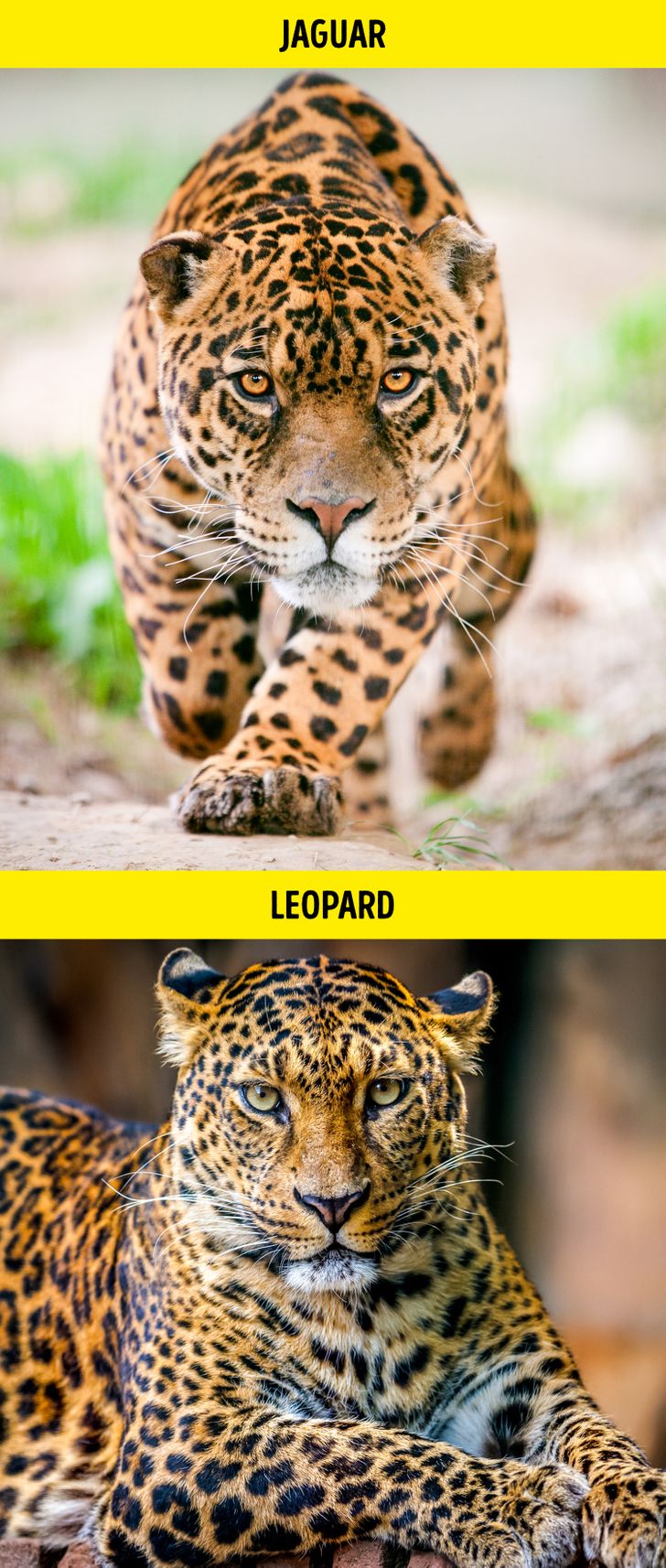
Despite their similarities, these big cats inhabit different continents and climate zones: leopards live in African savannas, while jaguars dwell in South American tropical forests. Jaguars are also larger and bulkier, and unlike leopards and many other cats, they’re fond of water.
2. Alligator vs crocodile
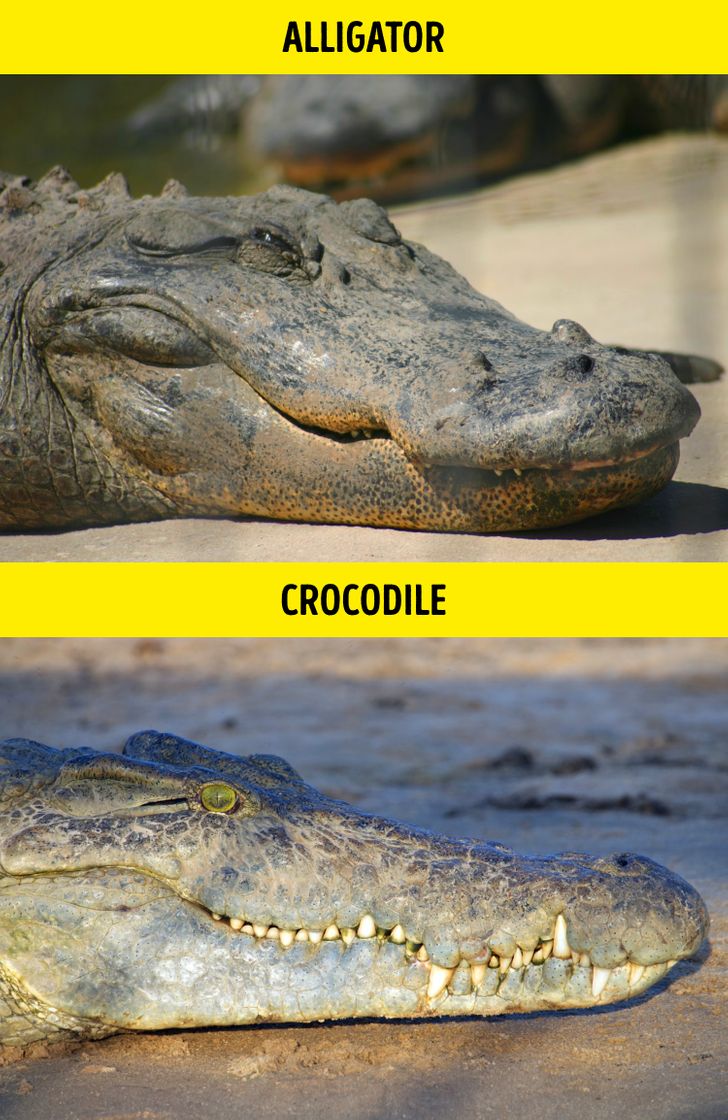
You can easily identify these 2 by the shape of their snouts: crocodiles have prominent, elongated V-shaped faces while alligators have shorter, wider U-shaped ones. Also, consider the teeth: crocodiles display their trademark toothy “grin” with every fourth tooth visible. Conversely, the alligator’s upper jaw is broader than the lower one, so its teeth aren’t visible for the most part.
3. Wasp vs hornet
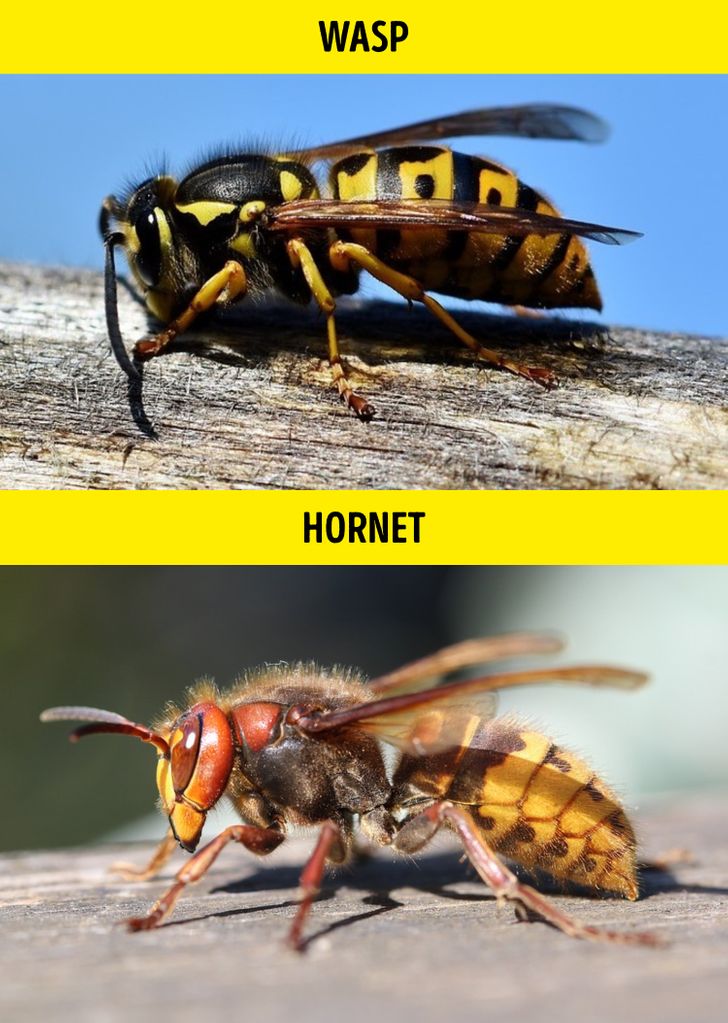
Both insects are menacing, that’s for sure. Hornets are larger and boast orange and black coloring, resembling spots rather than stripes, while wasps are more brightly colored and have yellow and black rings. You’re better off avoiding both.
4. Seal vs sea lion
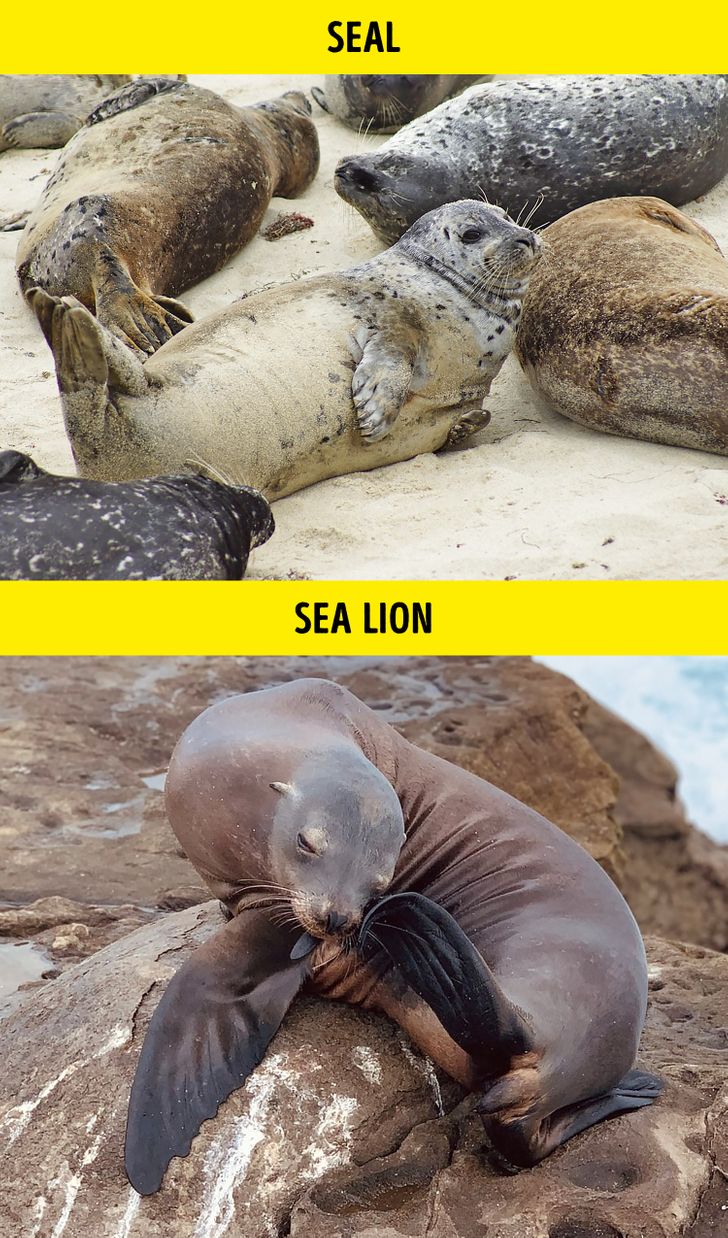
You’ve most likely met seals as cute plushy animals and sea lions as circus acrobats. Seals are covered with fur and have tiny front flippers which prevent them from walking, forcing them to wiggle on their bellies. Sea lions have smooth skin and vast flippers that they use to move on the ground.
5. Turtle vs tortoise
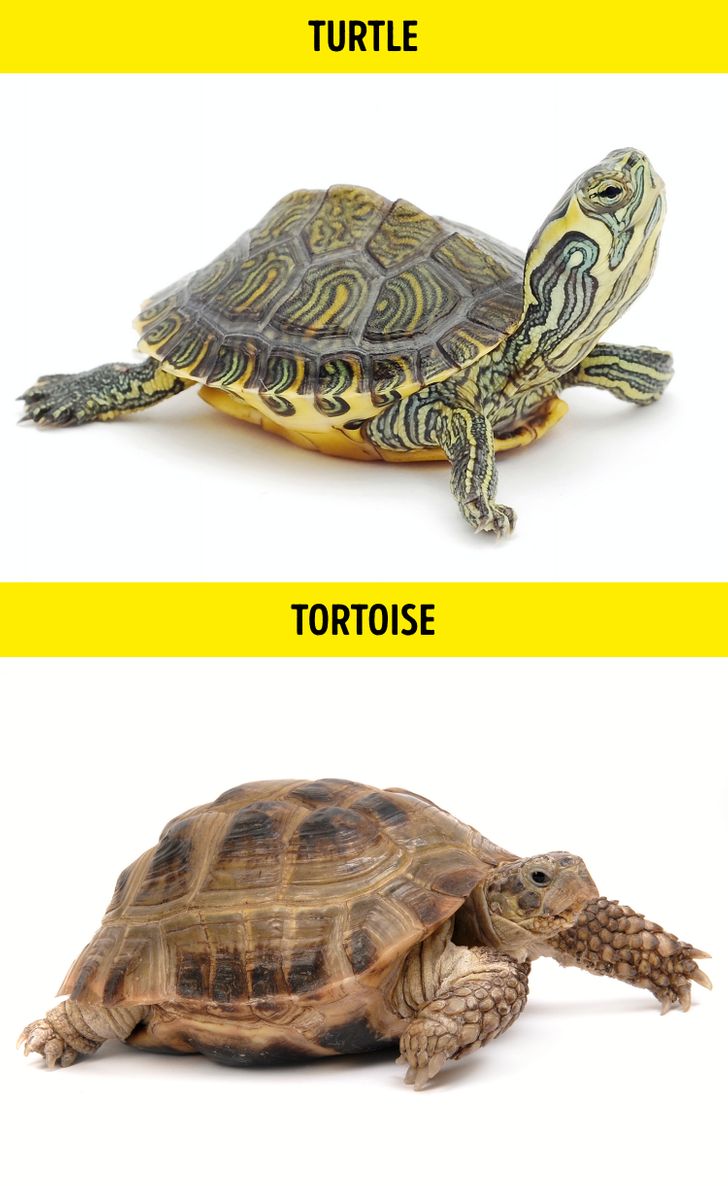
These 2 are both mobile (but very slow at that) and boast 4 legs. But the “turtle rock” is aquatic and has markings that resemble stains and circles on the water to better hide in the ponds. The “tortoise rock” is a land animal and spends most of its time on the ground — that is, as a literal rock.
6. Raven vs crow vs rook vs jackdaw
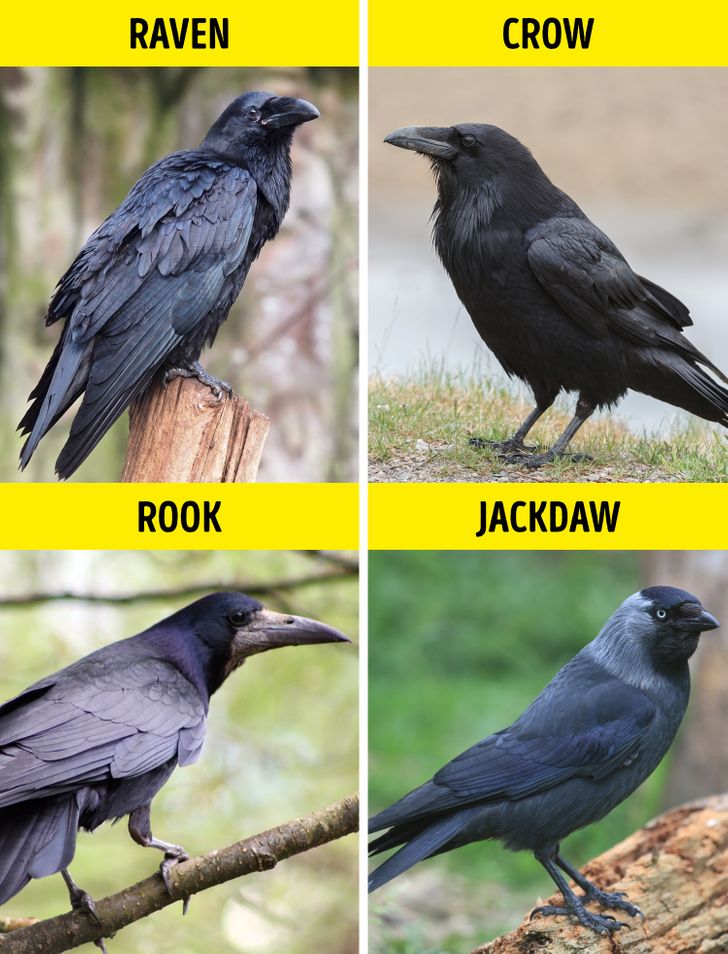
Most corvids look fairly similar (excluding jays who are like a theatre kid in a goth family). Ravens are the loftiest and most fashionable thanks to their “beard” of throat feathers. Crows and rooks are of the same size, but rooks have a distinct grey beak and fancy feather “pants” on their legs. Jackdaws are the goofiest-looking thanks to their very short beaks and a round heads with black caps.
7. Donkey vs mule
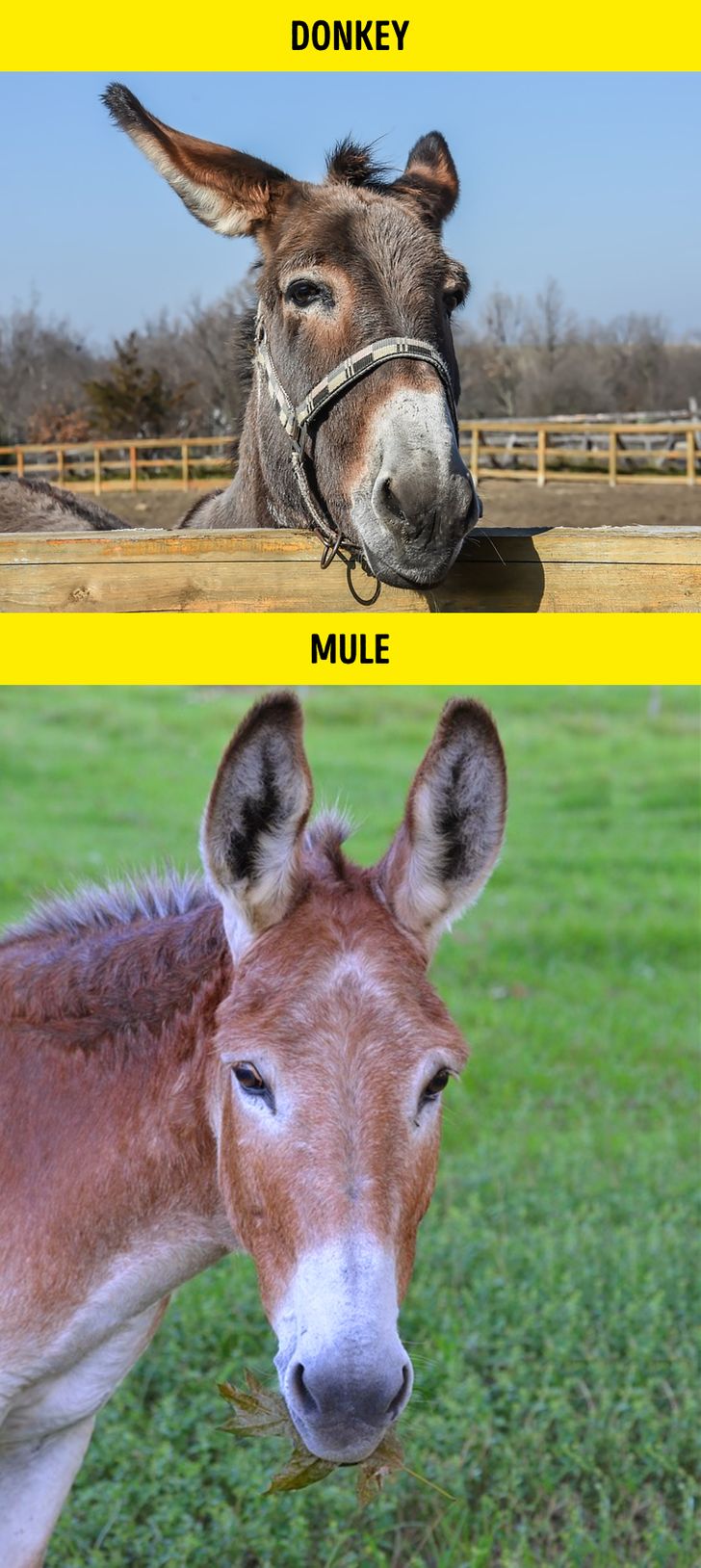
This one is tricky for a simple reason: while the donkey is its own species, a mule is a hybrid of donkey and horse. Funnily enough, it looks exactly like what you’d think these 2 animals would look like: an elegant head of a horse with ridiculously oversized donkey ears.
8. Hare vs rabbit
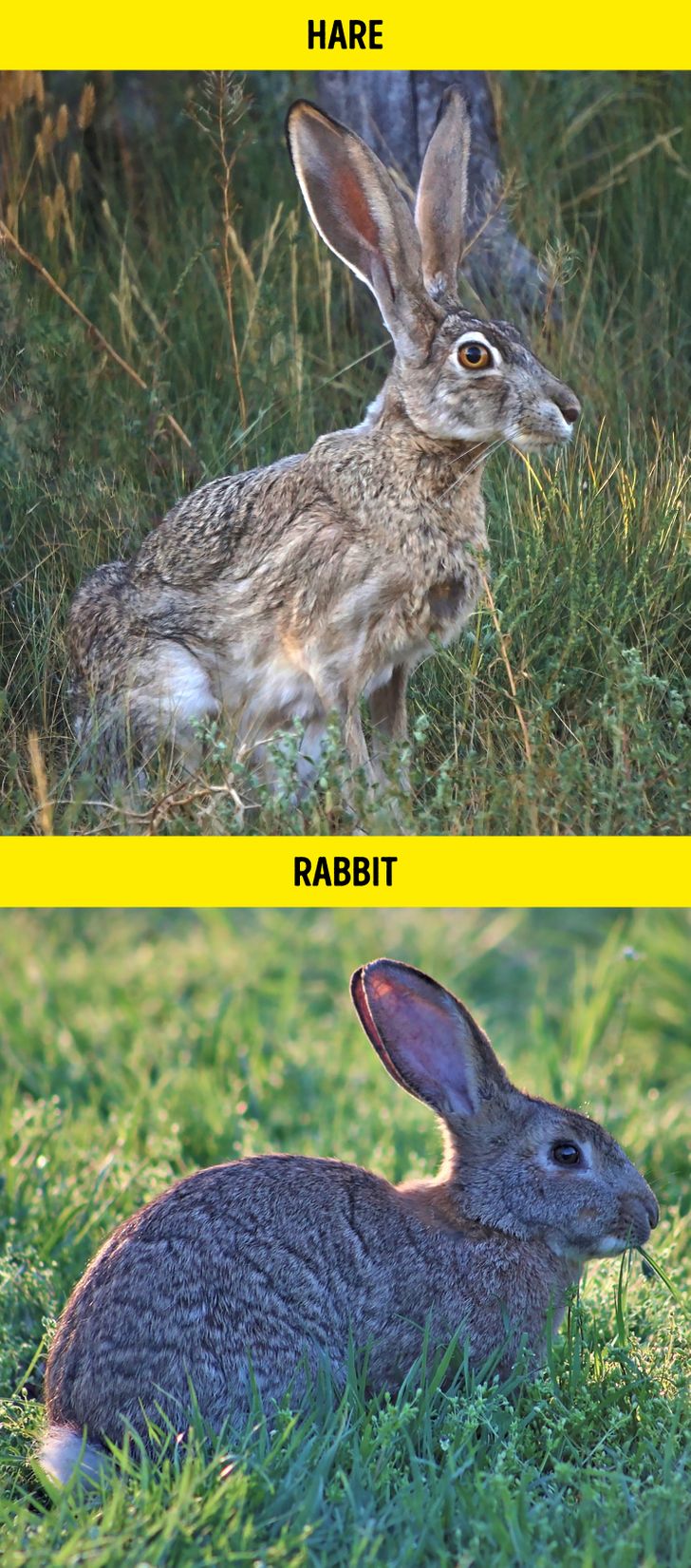
If you want a cuddly little pet, a rabbit is your best bet, but a hare definitely is not. Hares are larger and faster and have longer legs and ears. Rabbits are smaller, fluffier, and overall “cuter.” They even eat different food: rabbits prefer vegetables (like carrots) and soft grass while hares prefer bark and twigs. Rabbits are social animals while hares tend to be solitary. It’s no wonder rabbits are easily domesticated while hares mostly stay feral.
9. Moth vs butterfly
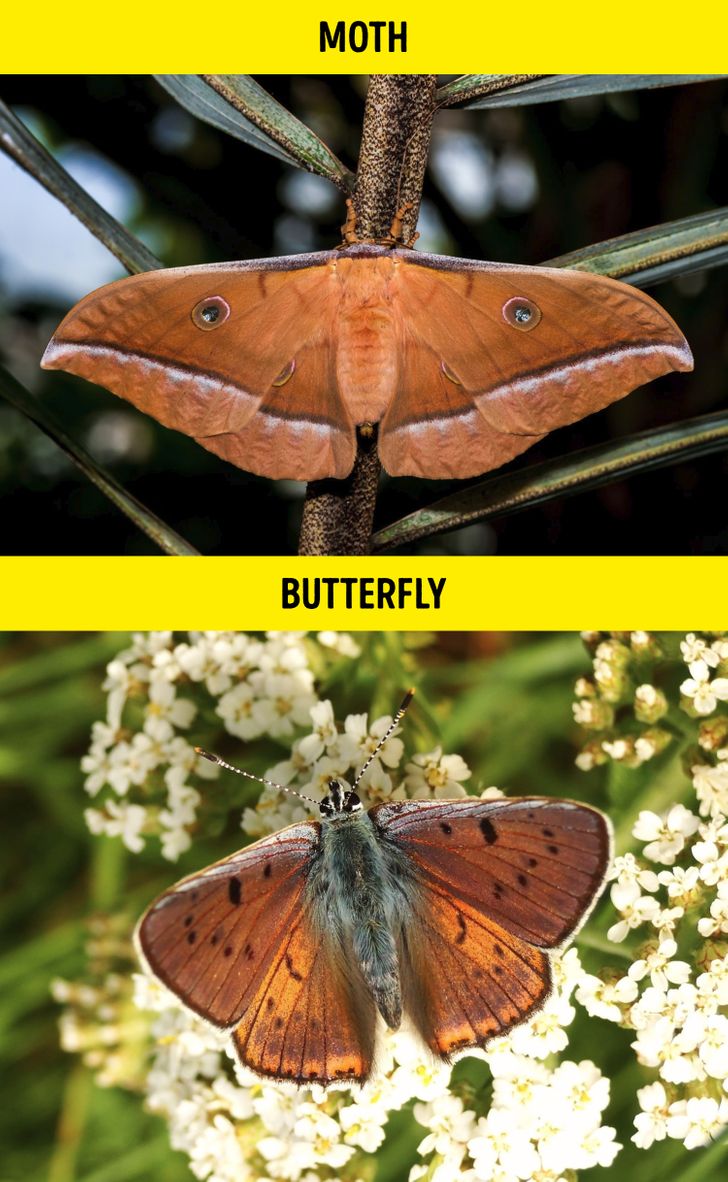
Moths have tent-like wings while butterflies flap their wings vertically. Moths usually rest with their wings open, while butterflies rest with their wings closed. Their antennas also differ: butterflies’ are long and thin and moths’ are short and feathery. Butterflies are strictly diurnal, while moths are mostly nocturnal.
10. Dolphin vs porpoise
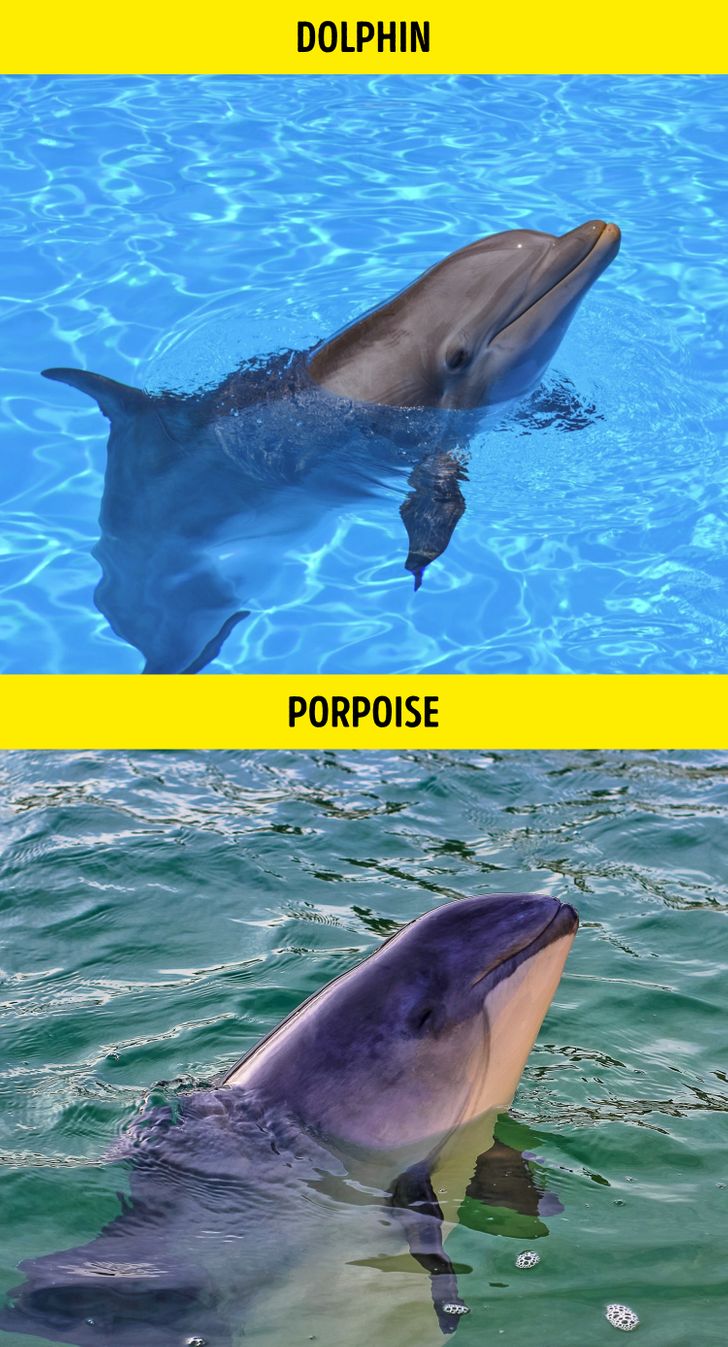
The difference between dolphins and porpoises comes down to their snouts, fins, and figures. Dolphins have long “beaks,” slender bodies, and curved dorsal fins. Porpoises have more flat, sloping faces, smaller flippers, and shorter triangular dorsal fins.
11. Weasel vs stoat
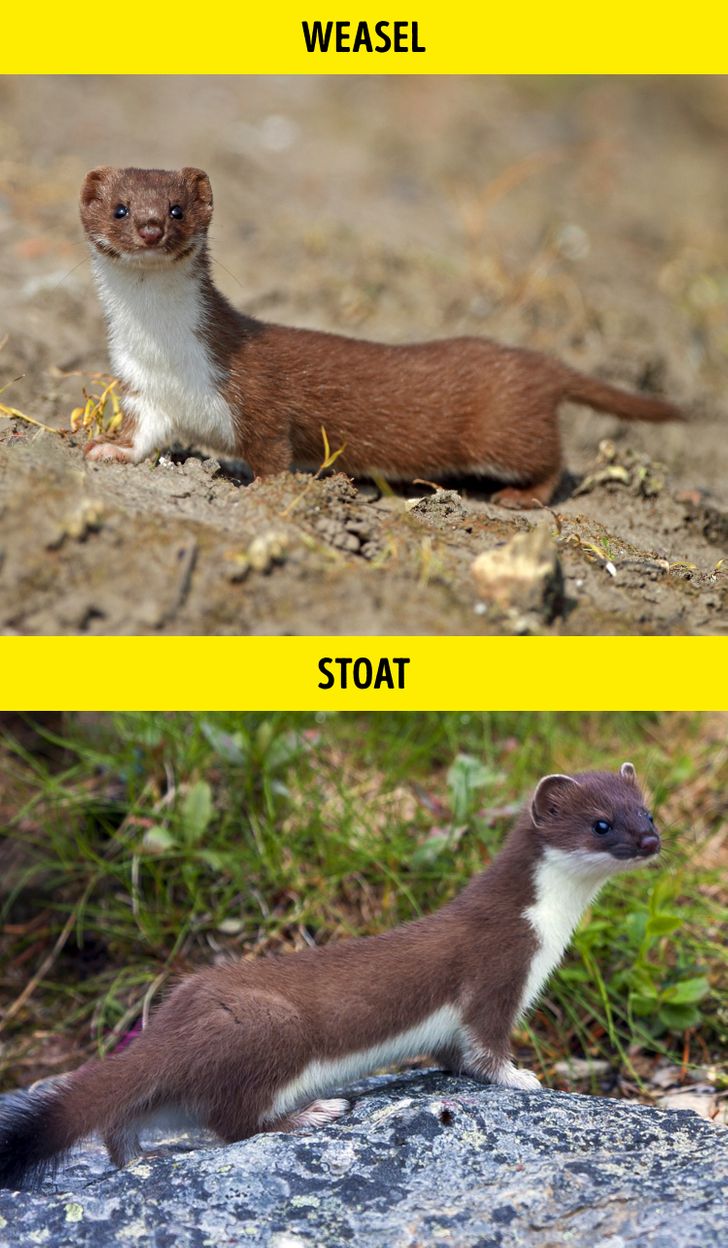
These 2 animals are close relatives. Stoats are bigger and have long tails with fuzzy black tips, while weasels’ tails are short and of the same color as the rest of the body. Stoats move in a bouncing gait with an arched back which looks hilarious, and weasels keep closer to the ground. Stoats also turn white in winter.
12. Eagle vs hawk vs falcon
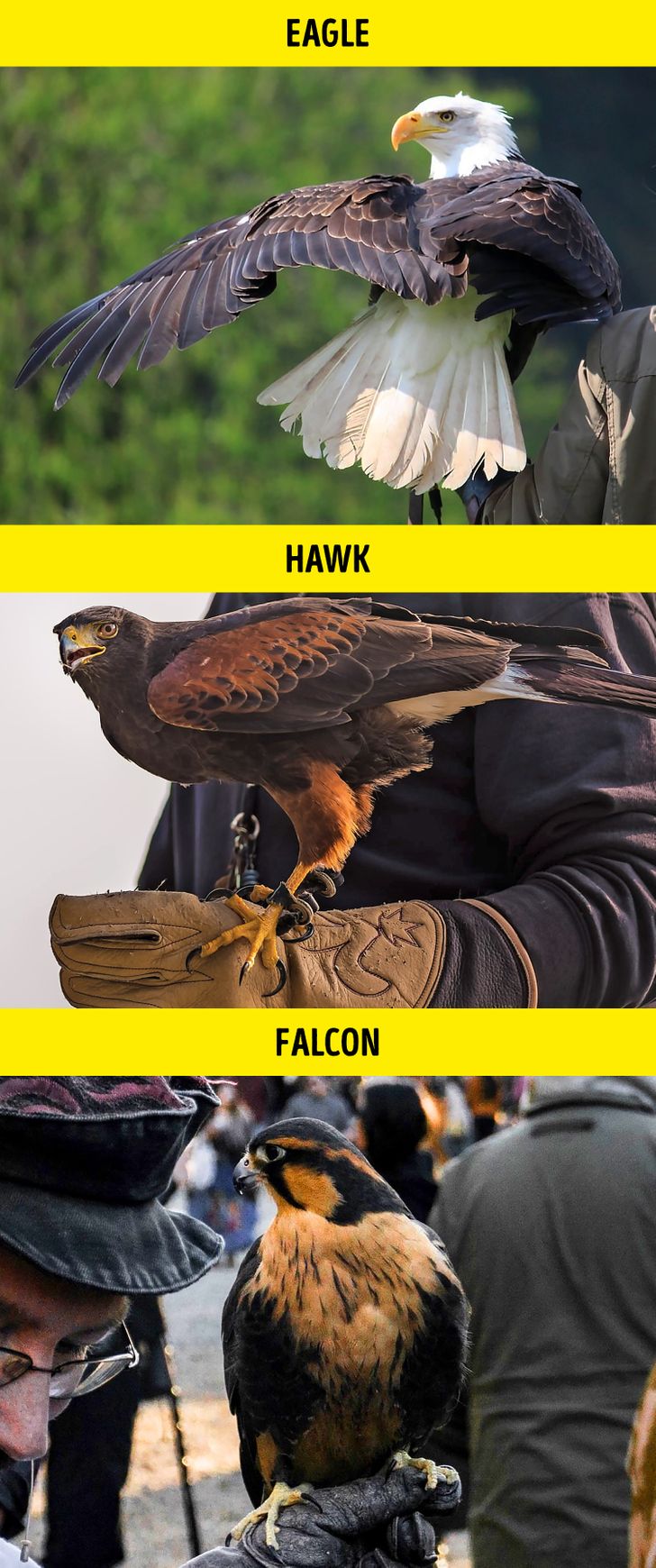
Eagles are gigantic, powerful birds who prefer to live in open spaces like cliffs and mountains. Hawks are a little smaller and more nimble in the air, capable of maneuvering in more closed areas. Falcons are the smallest and fastest of the 3 and differentiate the most visually: they have larger eyes and shorter beaks.
13. Mouse vs rat
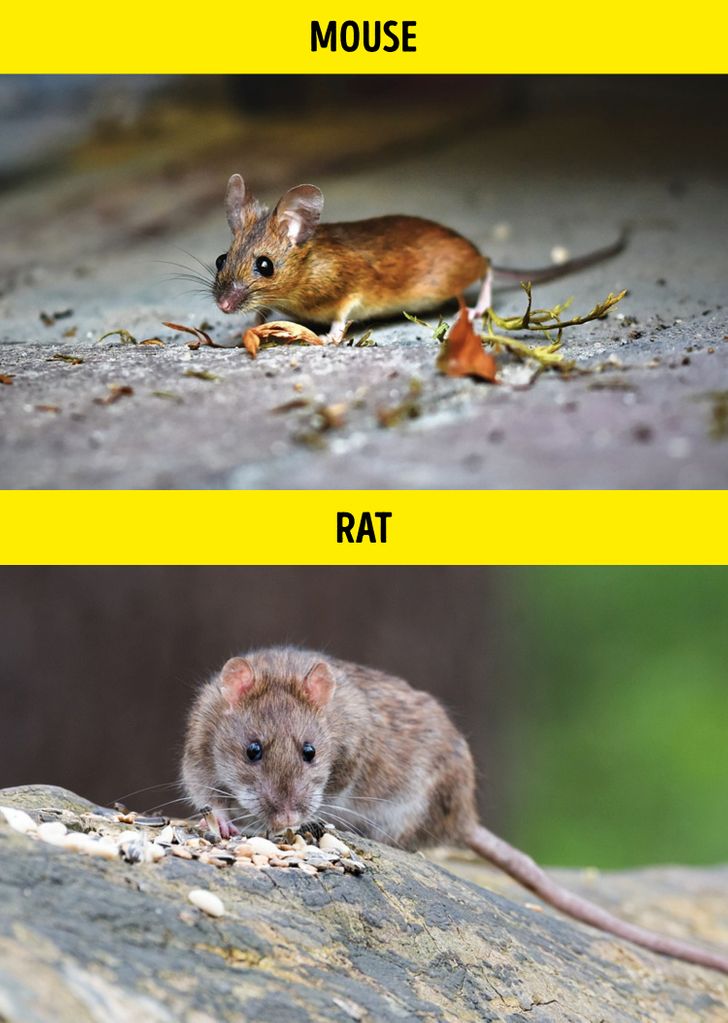
The 2 most famous (or infamous) rodents can be easily distinguished by 3 things: their size, tail, and ears. Mice are diminutive, even compared to young rats; they have thin long tails covered with fur while rats’ tails are thick and hairless. Mice have ears that are bigger in proportion to their bodies and are round and floppy with a tiny, triangular face. Rats’ faces are more prominent and blunt.
14. Seagull vs albatross
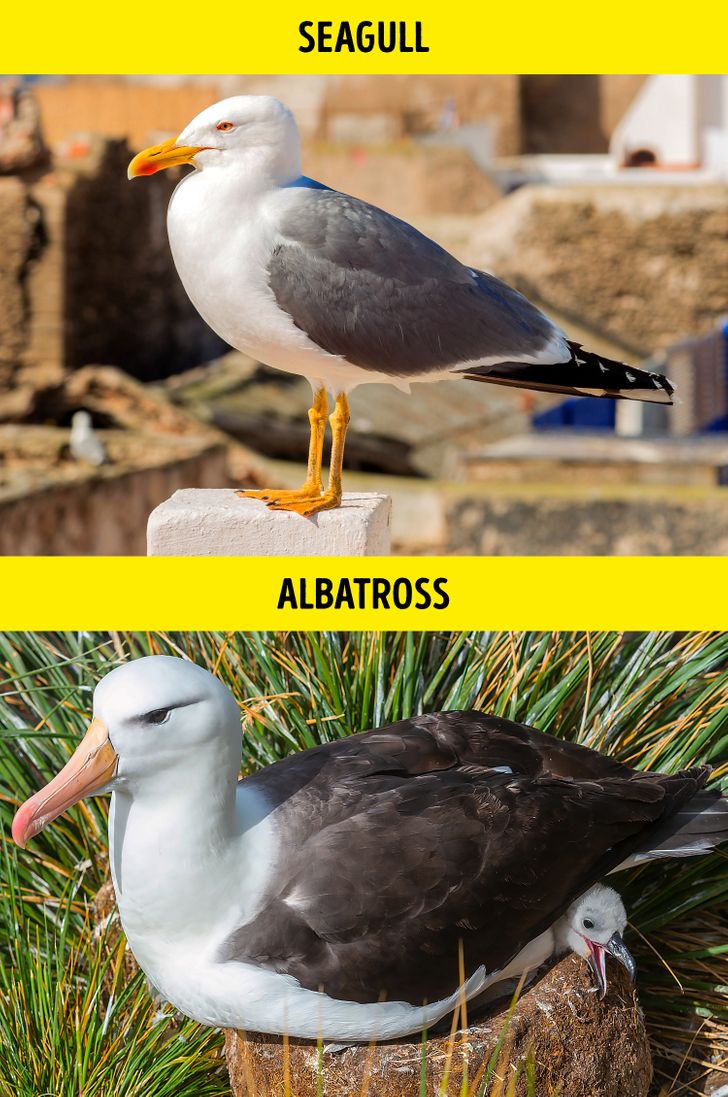
Gulls often live near water, be it the sea or ponds, and are rather acrobatic while diving and fish-catching, but aren’t fans of long voyages, unlike albatrosses. Albatrosses are portly birds who live in constant flight over the sea. They even have unique nostrils that allow them to remove salt from water and food.
15. Wolverine vs honey badger
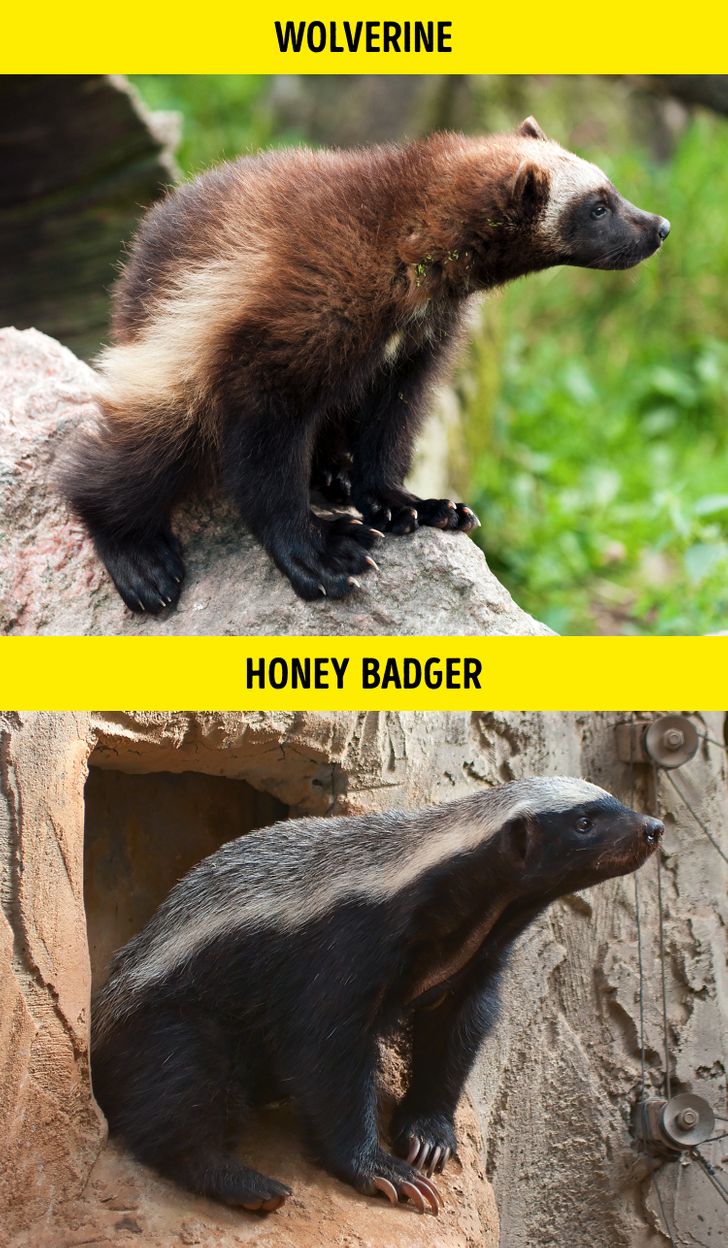
Despite living in different climate zones — the honey badger that lives in Africa and the wolverine that resides in the northern forests — both belong to the Mustelidae family. Wolverines are taller with longer legs and noticeable ears and have brown fur with yellow rings. Honey badgers keep closer to the ground and have black bodies with a white “cape” on their backs.
16. Wolf vs coyote vs jackal
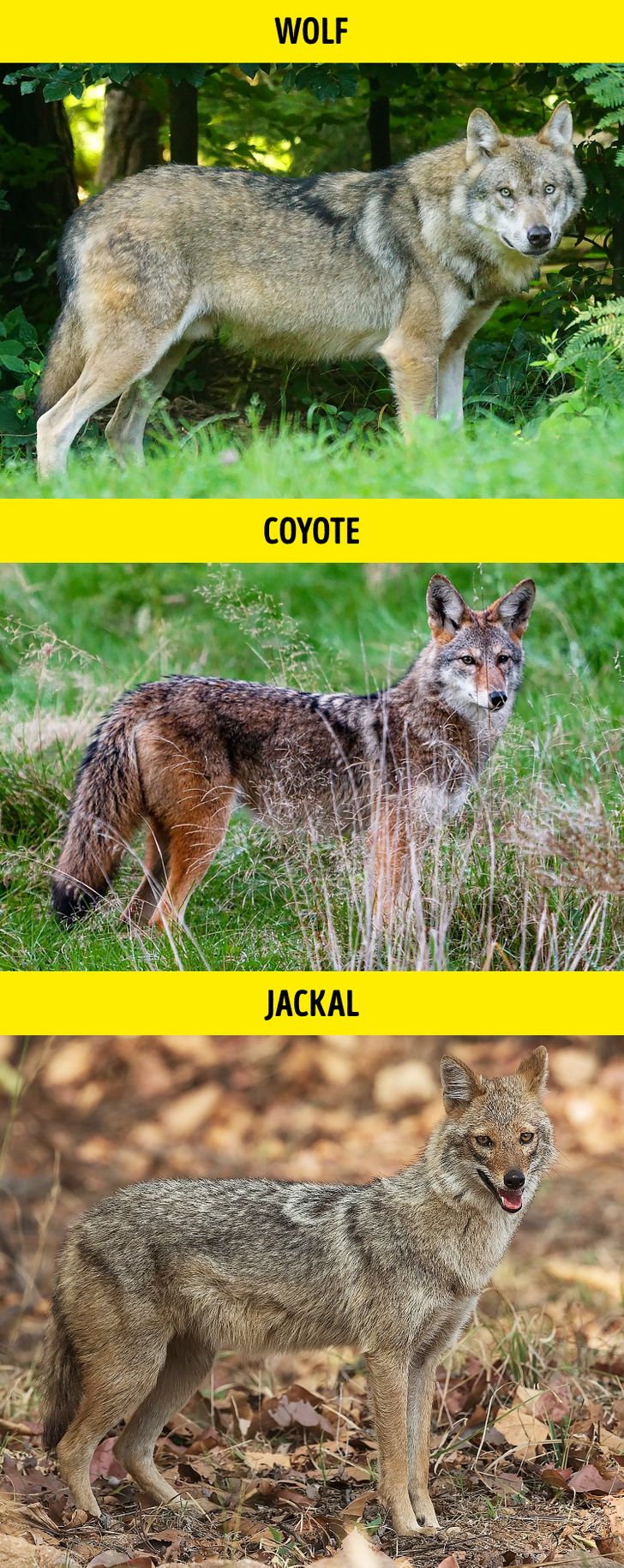
These 3 are “good boys and girls” that parade all over the globe. Jackals live in Africa, Asia, and India; coyotes live in Northern America; and wolves live all over the place. Wolves are large, sturdy animals, while coyotes and jackals possess a more lean and fragile frame.
Coyotes are recognizable for the red fur on their faces and ears while jackals have a more yellow-colored coat. Additionally, jackals are noticeably less fluffy because they don’t have to endure the harshness of winter.
Funny bonus: Wolverine vs the honey badger
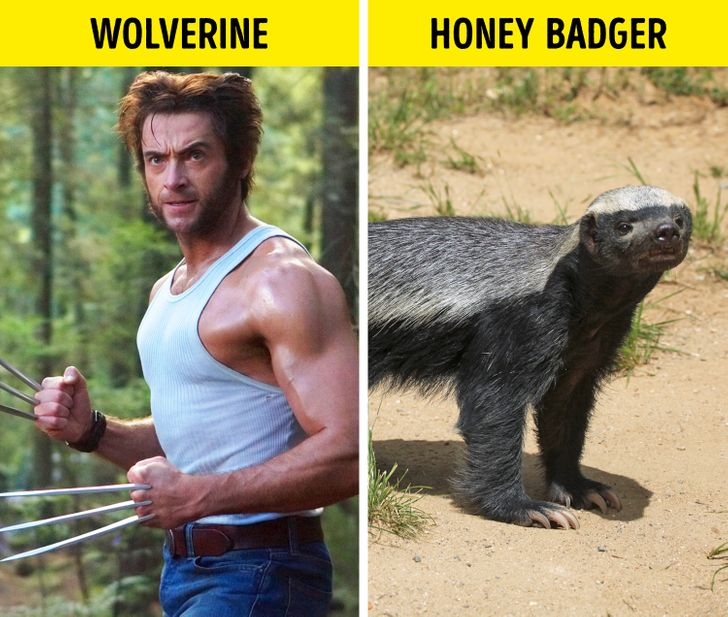
What kinds of animals have ever confused you? If you know more examples, share them in the comments!
Preview photo credit shutterstock.com, shutterstock.com
My 7-Year-Old Drew a Picture of My Husband with Another Woman and Wrote, ‘I Can’t Wait for You to Be My Mom’

When Amber, a hardworking mom and corporate attorney, discovers a drawing by her 7-year-old daughter, Mia, her world is shaken. The picture shows Mia’s teacher in Amber’s place with a heartbreaking caption. Suspecting betrayal, Amber confronts her husband, Jack, only to uncover something deeper… Mia’s feelings of abandonment amidst Amber’s busy life.
I didn’t think I’d be here… but this has been life lately.
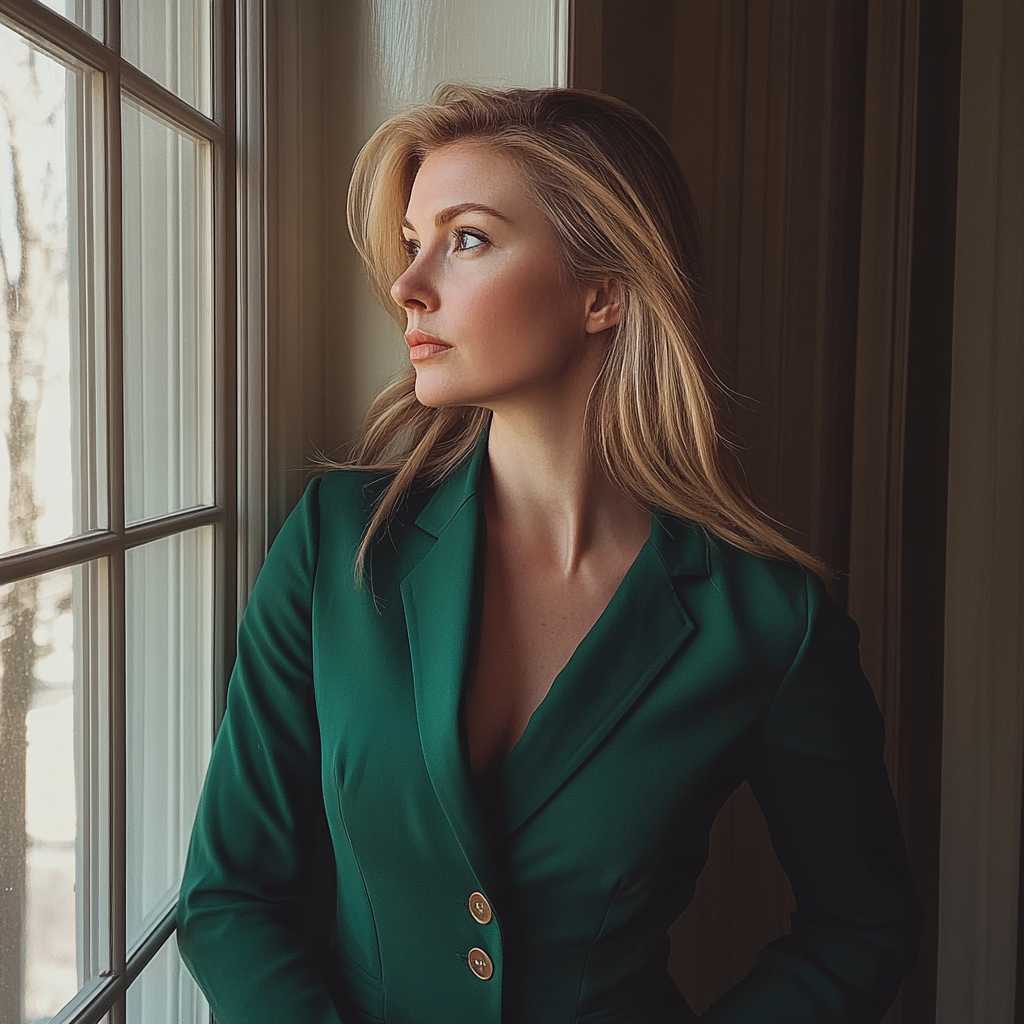
A woman looking out the window | Source: Midjourney
I’m Livia, I’m thirty-four, married to my husband Jack for ten years, and I’m a mom to my bundle of joy, Mia, a seven-year-old little girl. Recently, I’ve been busier than I’ve ever been in my entire life, which is truly saying something because I’m a corporate attorney.
My mom’s health has been declining over the past year, and we’ve been throwing ourselves into her hospital stays, therapy sessions, and medication that costs way more than I care to admit.
To cover everything, I’ve been working insane hours because I’d do anything for my mother.

A woman sitting in a hospital bed | Source: Midjourney
Anything.
Jack has been the best partner and rock I could have ever asked for. He has stepped up at home in ways I never imagined or expected. Jack has taken on the cooking, cleaning, helping Mia with her schoolwork, and managing all the little things I used to handle.
He made it possible for me to keep everything afloat, even when it felt like I was drowning.

A father and daughter duo sitting on a couch | Source: Midjourney
But last night, everything changed before I could even catch my breath.
I came home late, exhausted, starving, and ready to collapse. After hurriedly eating a bowl of salmon and rice while Mia took her bath, I put my little girl to bed. As she dozed off, Mia mumbled something about puppets.
“I didn’t know that you could put your hand in a socket and it would be a puppet,” she said.
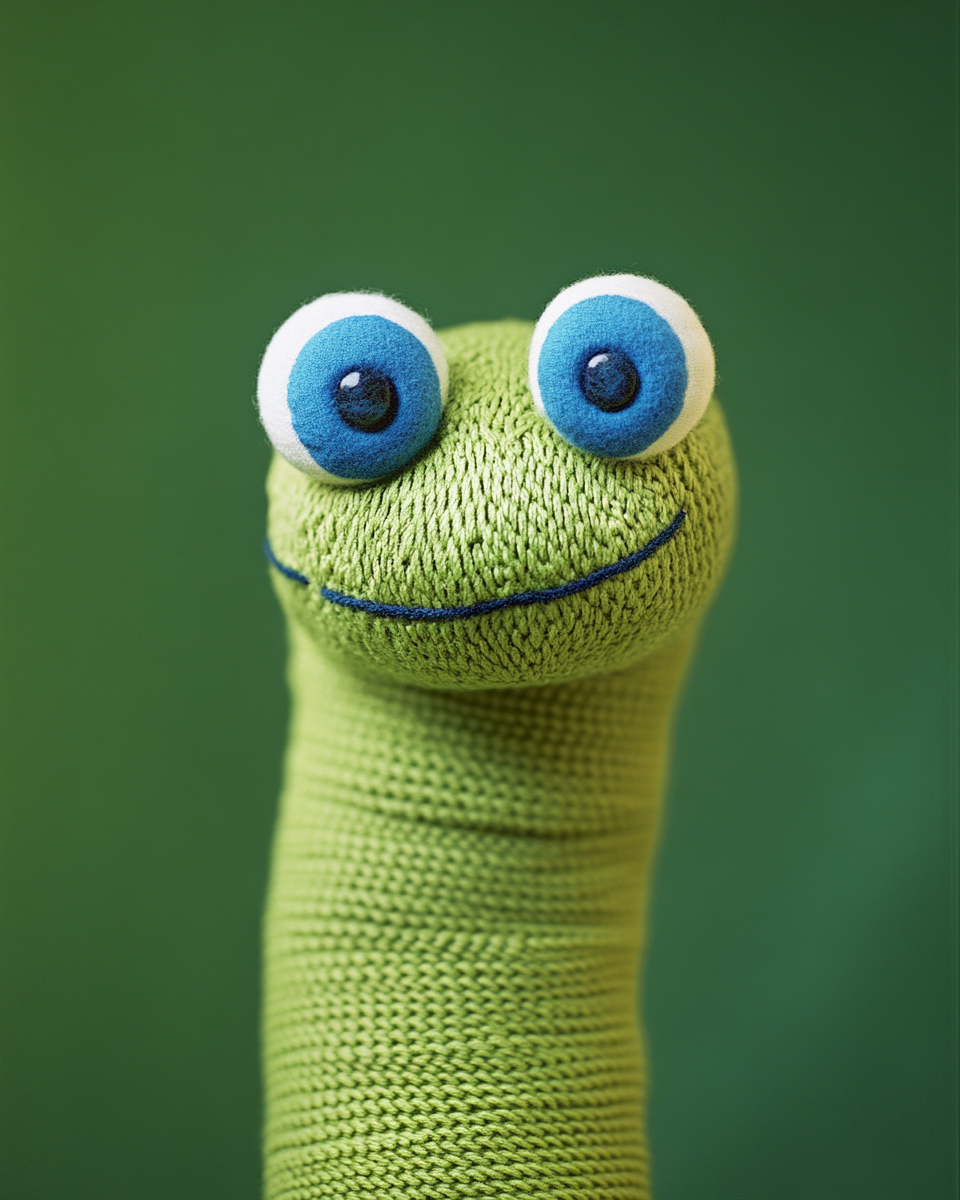
A green sock puppet | Source: Midjourney
“A sock, my darling,” I said. “Not a socket! Don’t you ever put your hand in a socket, Mia.”
She giggled.
“Okay, Momma,” she said, yawning.

A yawning little girl | Source: Midjourney
I started tidying up her dolls, which were scattered all over the carpet in her room, and then made my way to the coffee table in the living room. Crayons, white paper, and coloring books were scattered all over.
That’s when I found it. A drawing.
At first glance, it seemed innocent enough. A kid’s sketch of a happy family. A man, a woman, and a little girl holding hands. But when I looked closer, my stomach twisted.
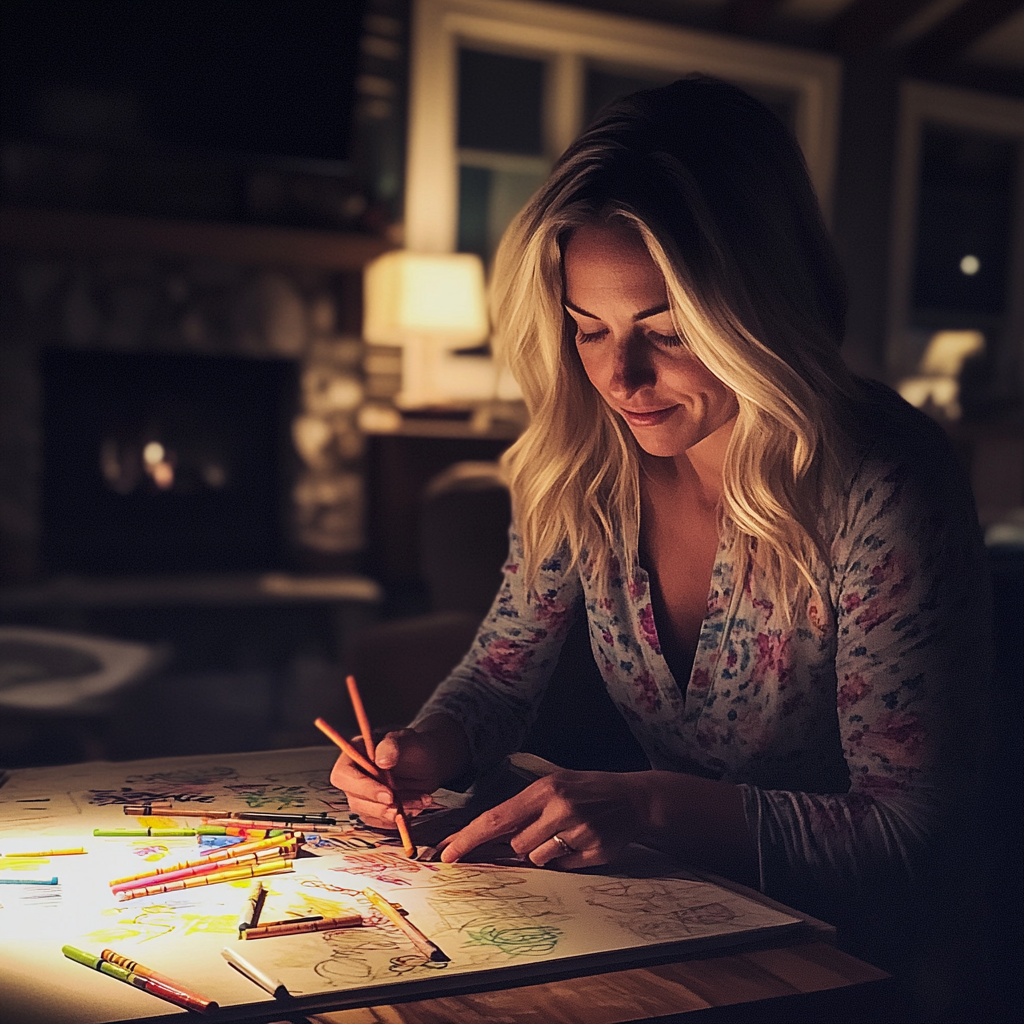
A woman gathering crayons | Source: Midjourney
The man was unmistakably Jack. The little girl was clearly Mia. But the woman? Definitely not me.
She had long brown hair and wore a flowing bridal gown. Beneath the drawing, in Mia’s little handwriting, were the words that broke my heart:
I can’t wait for you to be my mom!
It felt like the ground beneath me had given way.
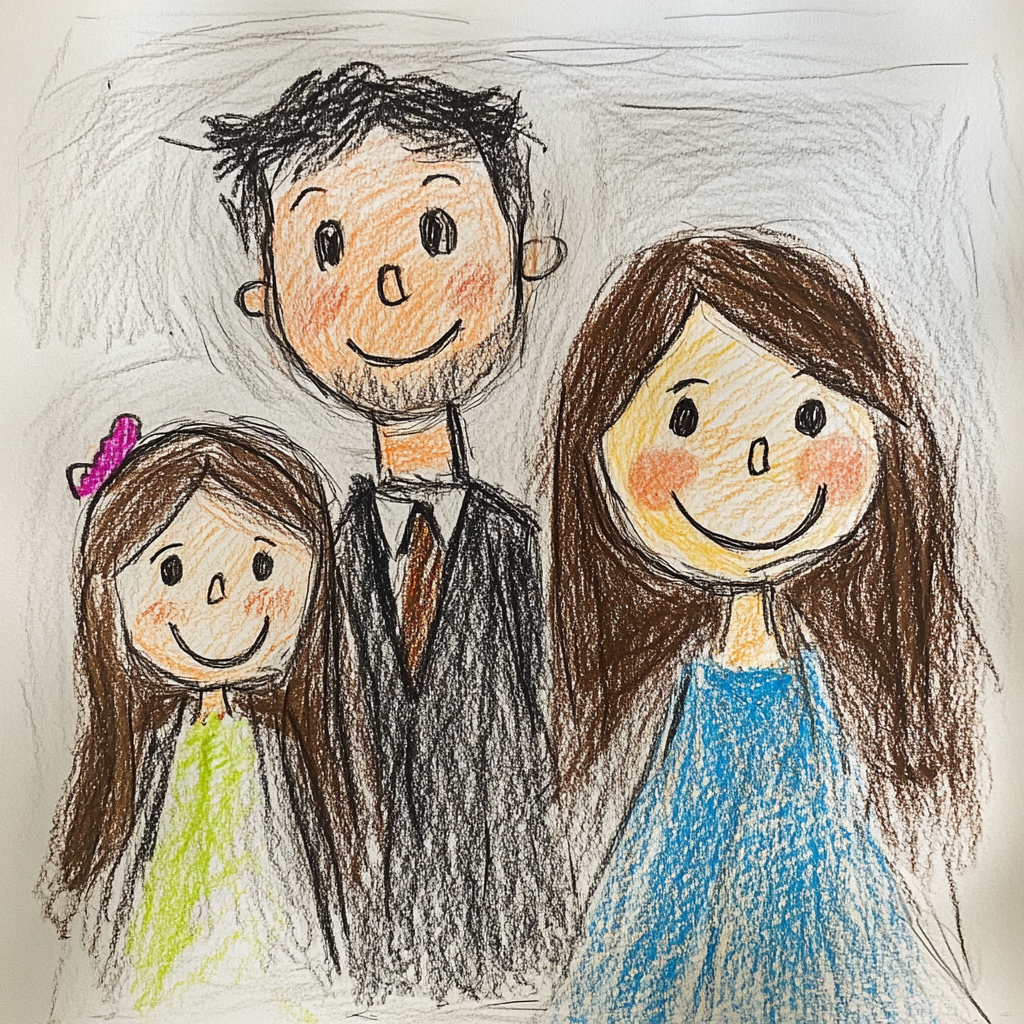
A child’s drawing | Source: Midjourney
I took the picture to Mia’s bed and sat on the edge, trying to wake her up enough to get answers.
“Darling girl, can you tell me about this drawing?” I asked her calmly.
“What drawing, Momma?” she asked, rubbing the sleep from her eyes.
When Mia took a look at the drawing, her face turned red, and she snatched the paper out of my hand, clutching it to her chest.
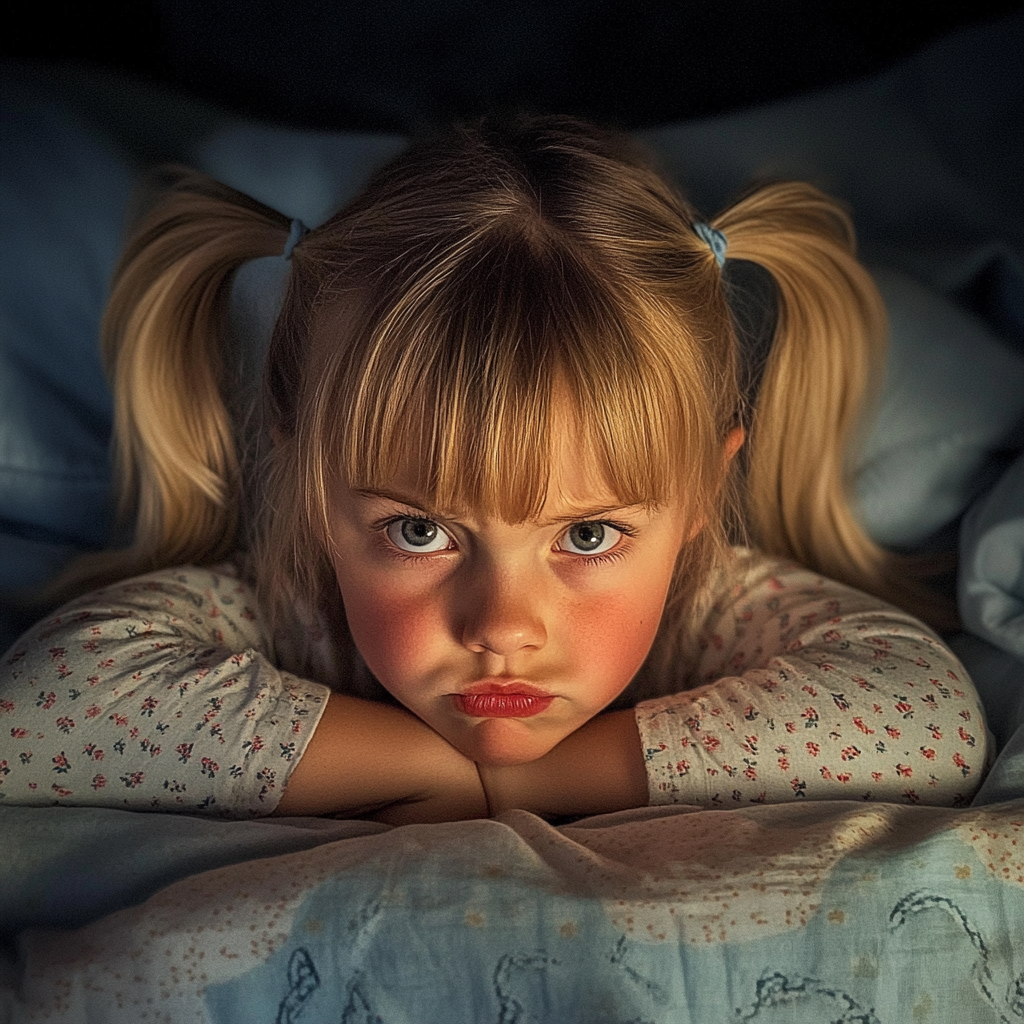
An upset little girl | Source: Midjourney
“You weren’t supposed to find that! Daddy said to hide it better!” she blurted out.
Hide it better? Jack? Hide what better?
My heart started pounding. What was going on? Was Jack cheating? And what was worse… was Mia already imagining this other woman as her mom?

An upset woman sitting on a couch | Source: Midjourney
I barely slept that night. My mind was running miles per hour. I thought about my mother, I thought about the work I still needed to do before heading to the office the next day, and I thought about my marriage…
By the morning, I had gone through a storm of worst-case scenarios. I sat in the kitchen, waiting for Jack to get ready for work. Mia had already left for school.
“What is this?” I demanded, thrusting the drawing into his hands.

An upset woman standing in a kitchen | Source: Midjourney
His eyes widened, and his face turned pale.
“You told her to hide it?” I asked. “You actually told Mia to hide it?”
“Wait, wait,” he stammered, holding up his hands defensively. “It’s not what you think, Amber. Let me explain it all to you.”

A worried man standing in a kitchen | Source: Midjourney
“You have exactly five seconds, Jack. I’ve been going crazy the entire night.”
My husband ran a hand through his hair, clearly distressed.
“Come with me,” he said.
“What? Where are we going? What about work?” I asked.

A man standing in a kitchen with his head bowed down | Source: Midjourney
“We’re going to Mia’s school. I need to show you something,” he said.
I wanted to scream at him, but something in his voice, an urgency that didn’t feel like guilt, made me agree.
The drive to the school was tense and silent, my mind still racing. What would Jack show me at Mia’s school that would change anything? Was there an imaginary friend or imaginary step-in mother waiting for us?

An upset woman sitting in a car | Source: Midjourney
When we arrived at the school, Jack squeezed my knee. As we walked to the reception area, he squeezed my hand and asked to see Mia’s teacher, Clara.
As soon as Clara walked in, I felt like I’d been punched in the gut. She was stunning, and for the life of me, I couldn’t remember why I hadn’t met her before. She had long brown hair, a bright smile, and an effortlessly bubbly demeanor.
She had to be the woman from Mia’s drawing, it was unmistakable.
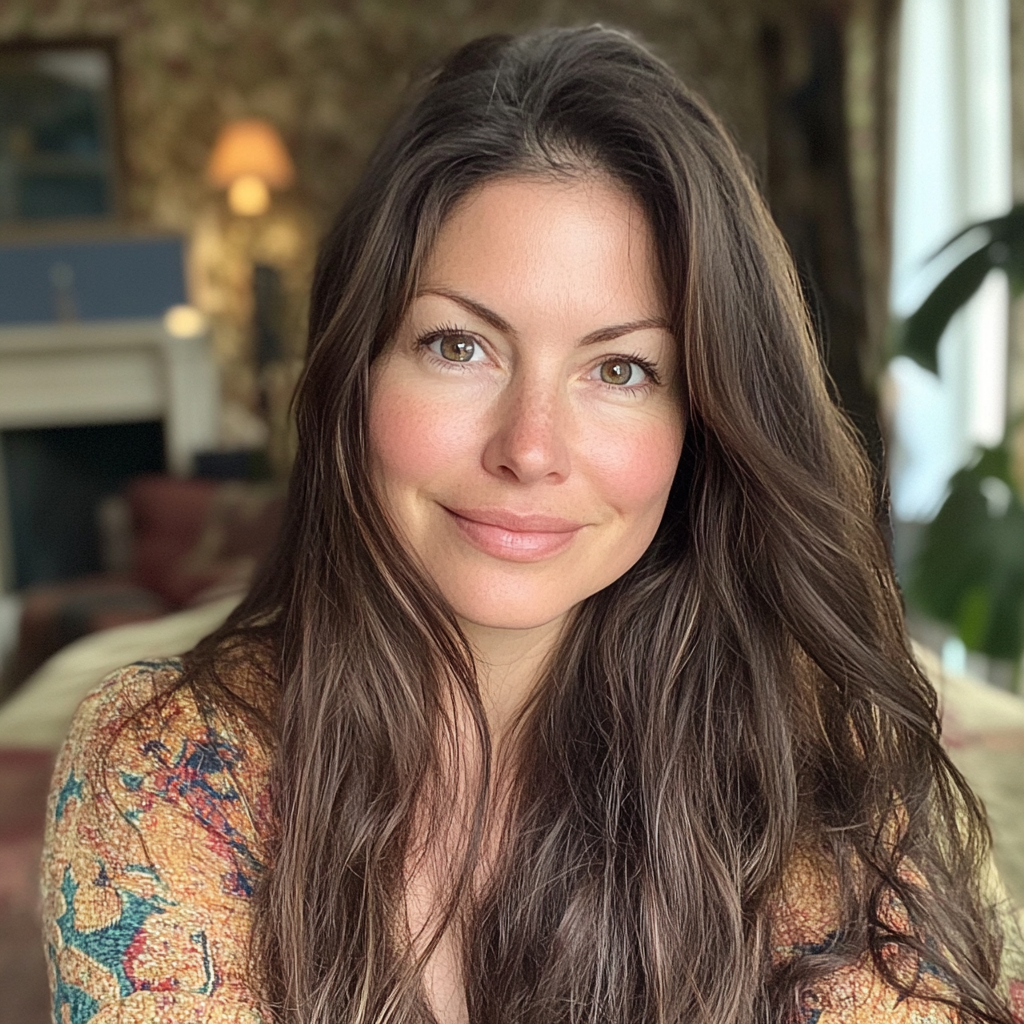
A smiling woman | Source: Midjourney
She smiled at Jack, and I wanted to scream.
“Clara,” Jack said. “Can you explain to my wife what’s been happening with Mia?”
Clara’s expression shifted to confusion but then softened as she glanced at me.
“Oh, of course,” she said.

A stressed woman | Source: Midjourney
She gestured for us to sit in the little room adjacent to the reception.
“Look, Mia’s been having a tough time lately,” she began. “She’s mentioned feeling like her mom doesn’t have time for her anymore. I’ve tried to reassure her, but she’s… well, look, she’s seven. And she’s been drawing a lot of pictures to process her feelings.”
Clara handed me a stack of drawings, and my heart sank as I flipped through them.

A stack of children’s drawings and coloring books | Source: Midjourney
Most were variations of the same theme. A happy family with Clara in my place. On the back of one of the drawings, there were more words I hadn’t noticed the first time:
Daddy and Clara.
“So, you’ve been spending time with my daughter?” I asked, unable to hide the edge in my voice.

An upset woman | Source: Midjourney
“Yes, of course,” she said. “But only in class, and I’m her teacher, after all. She stays after class sometimes to help me tidy up. She told me she feels like she’s losing her mom because you’re always busy. I’m so sorry if I overstepped. I’d never want to interfere…”
I turned to Jack, my chest tight.
“And you? What did you say to her about this?”

A stressed man | Source: Midjourney
Jack looked miserable.
“I found that picture last week,” he admitted. “I told Mia it wasn’t true, that you love her more than anything. But I didn’t know how to handle it. I didn’t want to make it worse by bringing it up when you were already so stressed out. I told her to put the drawing away because I knew it would hurt you.”
“You should have told me, Jack,” I said softly.
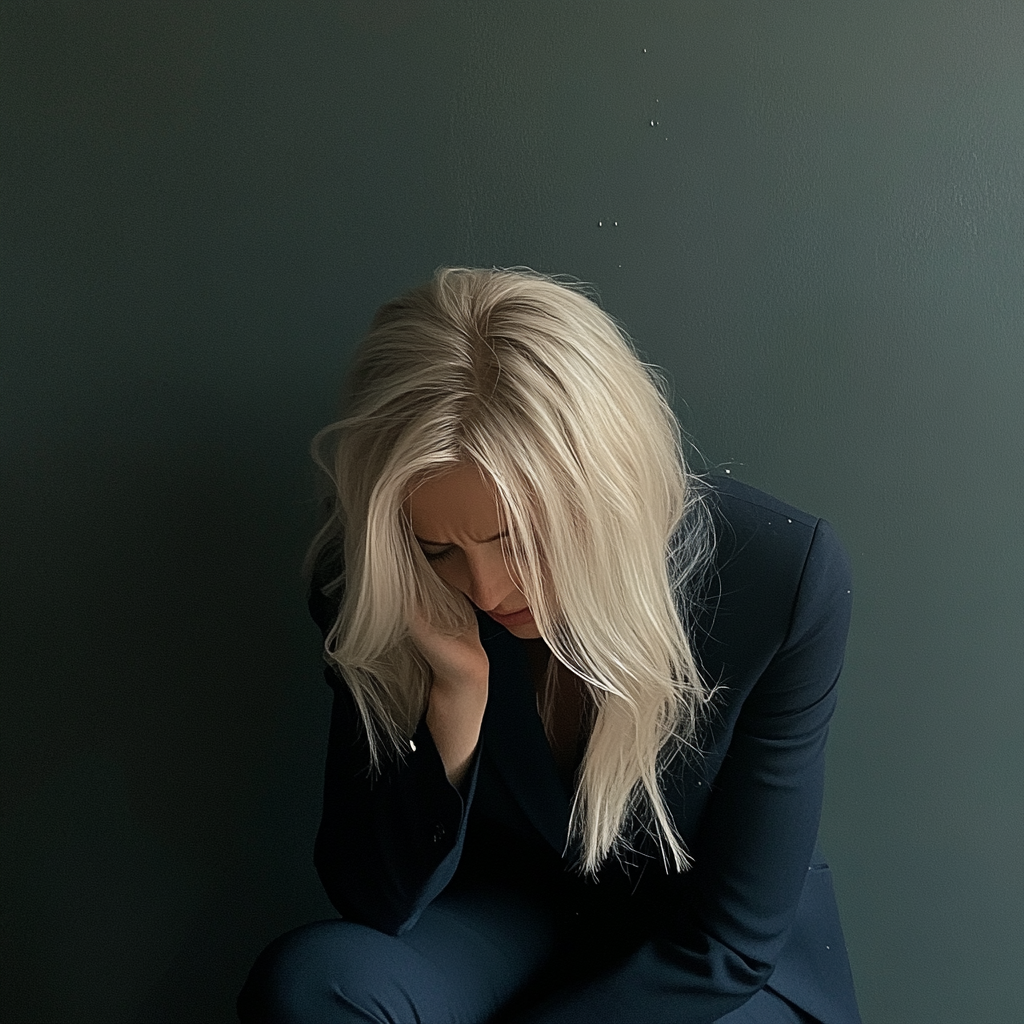
A woman holding her head | Source: Midjourney
I honestly didn’t know what to think.
Jack nodded, guilt in his eyes.
“I know, love,” he said. “I thought I was protecting you, but I see now that I just made it worse.”

An upset man | Source: Midjourney
My anger began to deflate, replaced by a wave of guilt so heavy it nearly knocked me off my seat. This wasn’t about Jack cheating or Clara overstepping. It was about my daughter, her sadness, her confusion, and her way of coping with my absence.
That night, I sat down with Mia at the kitchen table. I had dished us bowls of ice cream with all the toppings, hoping for a bonding moment between us.

Bowls of ice cream | Source: Midjourney
“Sweetheart,” I said softly. “I need to tell you something. I know I haven’t been around as much lately, and I’m so, so sorry. Grandma needs a lot of help right now, but that doesn’t mean I don’t want to be with you. You’re my everything, sweet girl.”
Mia’s eyes filled with tears, and she threw her arms around me.
“I thought maybe you didn’t like me anymore,” she whispered.

A little girl sitting at a table | Source: Midjourney
My heart shattered.
“I love you more than anything,” I said, holding her tightly. “Nothing will ever change that.”
In the weeks that followed, I made several lifestyle changes.
I cut back on work hours and asked my siblings to take on more of our mom’s care. Jack and I started a “Mom and Mia” night every week, just the two of us, doing whatever she wanted.

A little girl decorating cookies | Source: Midjourney
Sometimes it was baking cookies, other times it was a movie night, or building a fort, or sometimes it was just us dressing up and going on a date together.
I also had a heartfelt talk with Clara to thank her for being a wonderful teacher and being there for Mia when I couldn’t be.
She apologized again for any boundaries she might have crossed, but I reassured her that Mia’s drawings weren’t her fault.
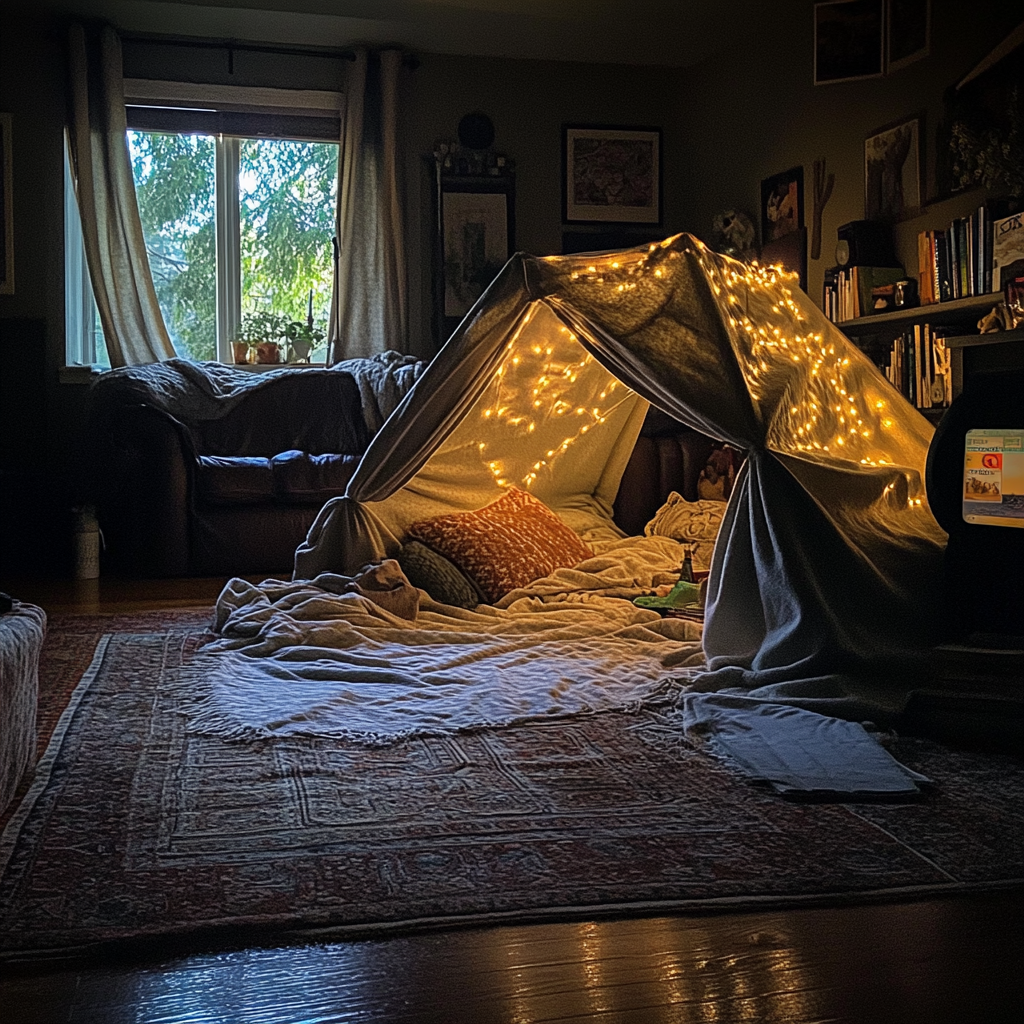
A blanket fort in a living room | Source: Midjourney
“I just feel bad, Amber,” she said as she cleaned up paintbrushes.
“I know, but you really shouldn’t, Clara,” I said. “You became a safe space for Mia, and you reminded her of how loved and cared for she is. That’s something I’ll always appreciate.”
Life isn’t perfect, but it’s a lot better. I’m learning to ask for help and to show Mia that she comes first. And now, every time she picks up her crayons, I make sure I’m sitting right next to her.
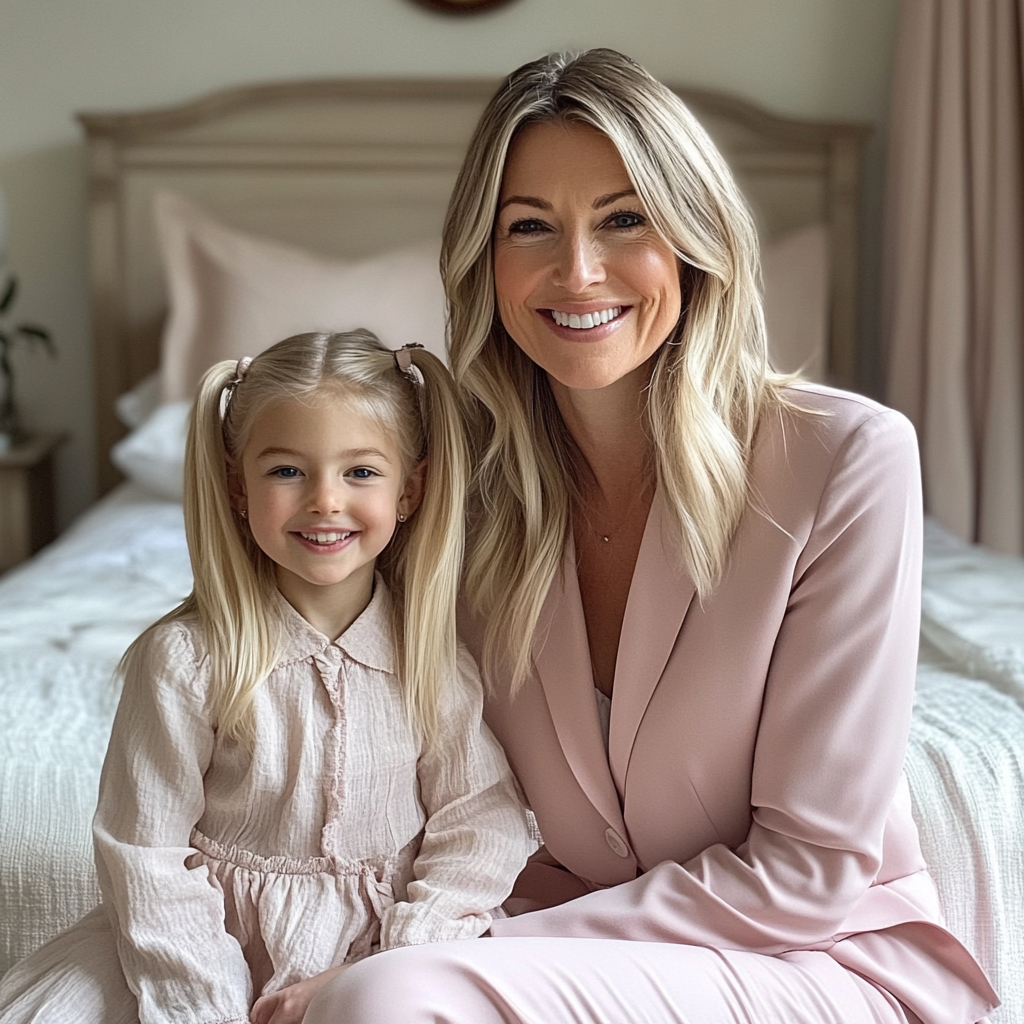
A smiling mother and daughter duo | Source: Midjourney
If you enjoyed this story, here’s another one for you: Sam used to be a mama’s boy, always clinging to Candice and lighting up at the sight of her. But one day, that changed. He started avoiding her hugs, her kisses, and even her presence. At first, I thought it was just a phase. But there was more to it. Much more.
This work is inspired by real events and people, but it has been fictionalized for creative purposes. Names, characters, and details have been changed to protect privacy and enhance the narrative. Any resemblance to actual persons, living or dead, or actual events is purely coincidental and not intended by the author.
The author and publisher make no claims to the accuracy of events or the portrayal of characters and are not liable for any misinterpretation. This story is provided “as is,” and any opinions expressed are those of the characters and do not reflect the views of the author or publisher.



Leave a Reply